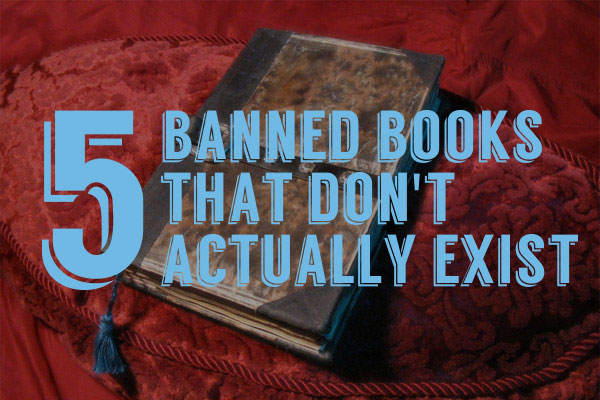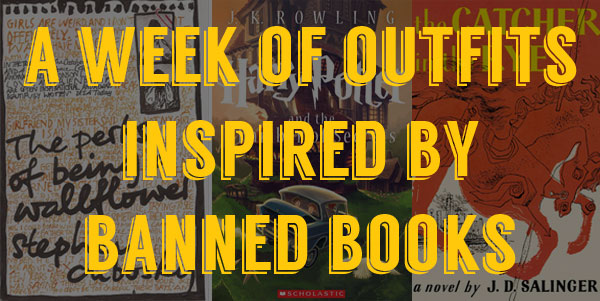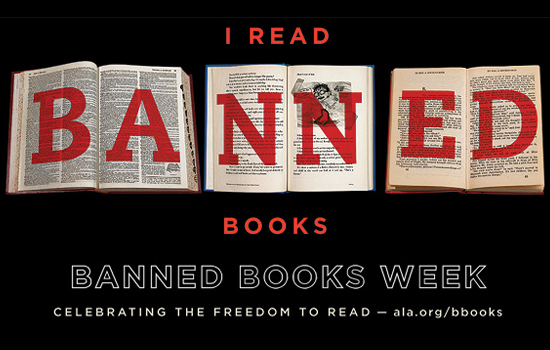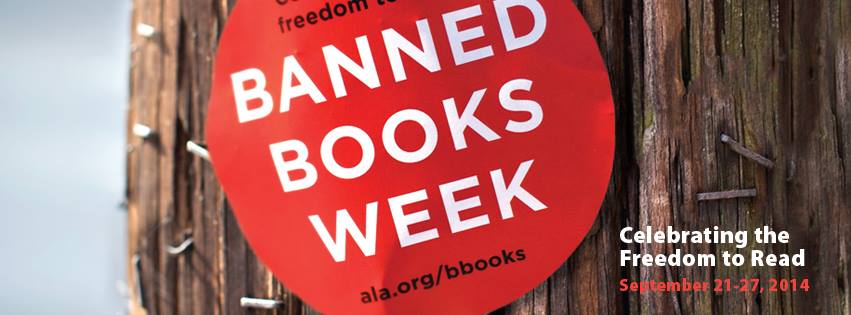Five Banned Books that Don’t Actually Exist
All over the planet people have tried to prevent others from reading books they consider immoral, unethical or just plain dangerous – and it seems that fictional worlds aren't safe from this either.
So in celebration of Banned Books week and the tireless efforts of librarians, publishers and booksellers to protect your right and freedom to read, here are five books that have been banned, suppressed or challenged in, um, books. (Warning: Spoilers!)
The Grasshopper Lies Heavy (The Man in the High Castle by Philip K Dick): In The Man in the High Castle, the Nazis won WW2 and America has been taken over by the Japanese. In this alternate history there is a book called The Grasshopper Lies Heavy, which is in itself another alternate history in which the Allies won the War. The Nazis have banned the book because they don't win in it, and they don't want people going around getting hope that they don't have to live under Hitler's oppressive rule.
To complicate matters, although the Allies win in Grasshopper, the reality portrayed in that book is vastly different from ours – Hitler lives to be tried at Nuremberg for a start. This means that The Grasshopper Lies Heavy is an alternate history of an alternate history of our reality. Still with me? Ok, next up we have:

The Doctor in Photons Be Free
Photons Be Free (Star Trek: Voyager): Okay this one is from a TV show, but still warrants a mention as a story suppressed by its own creator. The Emergency Medical Hologram (the Doctor) on board the USS Voyager decided to write a book that can be played on the Holodeck kind of like an interactive play – a Holonovel – in which the main character, also an Emergency Medical Hologram, is constantly mistreated by his colleagues.
The Doctor writes the book to highlight the plight of Mark 1 Holograms – of which he is one – who have been reduced to performing menial tasks . Unfortunately the characters in the book are obviously based on his crewmates, only obnoxious and cruel.
When the crew of the Voyager get to see the holonovel for themselves they are understandably upset, and the Doctor is made to see the error of his ways. He asks his publisher to hold off distributing the book – only to find that not only has it already made its way out across the galaxy, but as he is a hologram he doesn't even own the rights to it. Eventually he manages to have the book recalled but it is too late, and copies of Photons Be Free are still being distributed.
So basically, Photons Be Free is a fictional book written by a fictional hologram based on his fictional crewmates and intended to highlight the plight of other fictional holograms, which was then suppressed by its own fictional hologram creator, but continues to be experienced by the fictional holograms the book is supposed to support.
Yeah, it made my head hurt, too. Bringing us back to the present day, the next fictional banned book up for discussion is…
The Magdalene Diaries (The Da Vinci Code by Dan Brown): Even if you haven't read The Da Vinci Code, odds are you know how the story goes, and the odds are that you know how Dan Brown based the story on some complicated religious shenanigans involving everyone from Leonardo Da Vinci to the Knights Templar.
In amongst various highly controversial and potentially world-altering items is a document called the Magdalene Diaries; a text supposedly written by Mary Magdalene that would rock the very foundations of the Christian world. Now just to confuse matters most of the paintings, documents and pieces of art mentioned in The Da Vinci Code are real, even if their interpretation and their historical validity is up for debate. However there is no mention anywhere of the Magdalene Diaries prior to publication of The Da Vinci Code – they are definitely a product of Dan Brown's imagination.
Of course, books containing explosive and potentially dangerous information don't just belong to Dan Brown, and sometimes it is the good guys who indulge in a bit of censorship. For Example, Albus Dumbledore.

Photo via
The Secrets of the Darkest Art (Harry Potter by J K Rowling): Oh Dumbledore. Once a beloved hero of mine, I really have struggled to accept that he was a dirty book banner, however valid his reasons appear. The Secrets of The Darkest Art by Owle Bullock is a book that appears in Harry Potter and the Deathly Hallows, and contains details about how to make a Horcrux. The book was originally housed in the Restricted section of Hogwarts library, but was removed (see: suppressed) by good guy Albus Dumbledore when he realises that one of his students is spending an unhealthy amount of time contemplating immortality and world domination.
Admittedly the student in question – Tom Riddle – goes on to become Lord Voldemort so maybe Dumbledore had a point, but by removing the book from the library he effectively made it harder for the good guys to figure out how to defeat Voldemort and the Death Eaters. Add to that the fact that Hermione has the book in her possession for over a year and a) learns how to defeat Voldemort through the destruction of the horcruxes and b) doesn't succumb to an urge to murder her friends in order to achieve immortality, it goes to show that it is not the content of a book that is dangerous, but the way in which it is applied.
Speaking of dangerous ways to apply knowledge, let's finish up with the most famous fictional banned book of all time:
The Necronomicon (the works of H P Lovecraft): Originally appearing in Lovecraft's short story The Hound, the Necronomicon is an ancient book that includes an account of The Old Ones (see: evil rampaging alien demons), their history, and the methods of how they can be summoned.
According to Lovecraft, back in 1055 people took exception to the existence of a book that allowed people to call Cthulhu out of his eternal prison to destroy humanity, so they suppressed, banned and burned the book at every opportunity. Obviously they missed a few copies, and evil alien-worshipping cults across the globe use the Necronomicon in nefarious attempts to destroy the world.
As you do.
Now despite the fact that the Necronomicon is clearly an invention of Lovecraft, he was quite happy to let other people build on the concept until a whole Cthulhu mythos was established. Because of this, a frighteningly large number of people believe that the Necronomicon is a real book – and they want a copy of it. I might be opposed to censorship, but I can't help but feel that the people desperate to get their hands on a demonic grimoire aren't planning to use it for anything good.
Several versions are of the Necronomicon are currently in print, although not all of them are based exclusively on Lovecraft's mythos. Happily for humanity, the real world fake versions of the fictional Necronomicon don't have the ability to order pepperoni pizza, let alone one of the Elder gods.
—
So there you have it! Five banned books that don't exist in the real world – at least not in the way they do in the original texts that feature them. If you had the opportunity to add one to your personal collection, which one – if any – would you choose?




